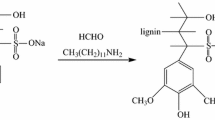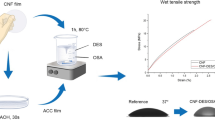Abstract
To convert the hydrophilic cellulose fiber into hydrophobic, multilayers composed of cationic polyacrylamide (CPAM) and lignosulfonate (LS) were constructed on cellulose fiber surface using layer-by-layer (LBL) self-assembly technique. The presence of CPAM/LS multilayers were validated by zeta potential, X-ray photoelectron spectroscopy and atomic force microscopy (AFM). It was found that potential of fiber surface inversed after deposition of each layer, the contents of characteristic elements (i.e. S and N) of CPAM/LS multilayers increased with increasing bilayer number, furthermore, the calculated surface LS content increased linearly as a function of bilayers. AFM phase images indicated that the cellulose microfibrils on fiber surface were gradually covered by LS granules, resulting in an increase in fiber surface roughness as self-assembly proceeded. The wetting properties of modified cellulose fibers were detected by dynamic contact angle measurement. The results showed that the initial water contact angle gradually increased and the attenuation rate of the contact angle gradually decreased with the number of bilayers, suggesting that the controllable hydrophobicity of cellulose fiber can be achieved depending on the number of bilayers. It also showed that the polyelectrolyte presented in the outermost layer significantly influenced the wetting properties of cellulose fibers, and a higher hydrophobicity was observed when LS was in the outermost layer. Moreover, tensile strength test was performed on the handsheet prepared from LBL modified fibers to evaluate the effect of CPAM/LS multilayers on strength property of cellulose fiber networks. The tensile index of handsheet prepared from fibers modified with a (CPAM/LS)5 multilayer increased by 12.4% compared with that of handsheet prepared from original fibers. The print density of handsheet increased with the number of bilayers, suggesting that printability of the handsheet was improved by constructing CPAM/LS multilayers on cellulose fiber surface. This strategy will have a positive impact and potential application value in printing process control of cellulose fiber-based products.












Similar content being viewed by others
References
Agarwal M, **ng Q, Shim B, Kotov N, Varahramyan K, Lvov Y (2009) Conductive paper from lignocelluloses wood microfibers coated with a nanocomposite of carbon nanotubes and conductive polymers. Nanotechnology 20:1–8
Cetin NS, Özmen N (2002) Use of organosolv lignin in phenol-formaldehyde resins for particleboard production I. Organosolv lignin modified resins. Int J Adhes Adhes 22:477–480
Decher G (1997) Fuzzy nanoassemblies: toward layered polymeric multicomoposites. Science 277:1232–1237
Decher G, Hong JD (1991a) Buildup of ultrathin multilayer films by a self-assembly process. 1. Consecutive adsorption of anionic and cationic bipolar amphiphiles on charged surface. Markromol Chem Macromol Symp 46:321–327
Decher G, Hong JD (1991b) Buildup of ultrathin multilayer films by a self-assembly process. 2. Consecutive adsorption of anionic and cationic bipolar amphiphiles and polyelectrolytes on charged surfaces. Ber Bunsen-Ges 95:1430–1434
Decher G, Hong JD, Schmitt J (1992) Buildup of ultrathin multilayer films by a self-assembly process. 3. Consecutively alternating adsorption of anionic and cationic polyelectrolytes on charged surface. Thin Solid Films 210:831–835
Deng YH, Wu Y, Qian Y, Ouyang XP, Yang DJ, Qiu XQ (2010) Adsorption and desorption behaviors of lignosulfonate during the self-assembly of multilayers. BioResources 5:1178–1196
Duker E, Lindströem T (2008) On the mechanisms behind the ability of CMC to enhance paper strength. Nord Pulp Paper Res 23:57–64
Eimansouri NE, Salvadó J (2006) Structural characterization of technical lignins for the production of adhesives: application to lignosulfonate, kraft, soda-anthraquinone, organosolv and ethanol process lignins. Ind Crop Prod 24:8–16
Eriksson M, Pettersson G, Wågberg L (2005) Application of polymeric multilayers of starch onto wood fibers to enhance strength properties of paper. Nord Pulp Pap Res J 20:270–276
Guo YM, Geng W, Sun JQ (2009) Layer-by-layer deposition of polyelectrolyte–polyelectrolyte complexes for multilayer film fabrication. Langmuir 25:1004–1010
Hasson S, Ostmark E, Carlmark A, Malmstrom E (2009) ARGET ATRP for versatile grafting of cellulose using various monomers. ACS Appl Mater Interfaces 1:2651–2659
He J, Kunitake T, Nakao A (2003) Facile in situ synthesis of noble metal nanoparticles in porous cellulose fibers. Chem Mater 15:4401–4406
Hubbe MA (2007) Paper’s resistance to wetting—a review of internal sizing chemicals and their effects. BioResources 2:106–145
Ingmansson WL, Thode EF (1959) Factors contributing to the strength of a sheet of paper. Tappi 42:83–93
Johansson LS, Campbell JM, Koljonen K, Stenius P (1999) Evaluation of surface lignin on cellulose fibers with XPS. Appl Surf Sci 144–145:92–95
Jung HJG, Ni W (1998) Lignification of plant cell walls: impact of genetic manipulation. Proc Natl Acad Sci USA 95:12742–12743
Kim SS, Park JE, Lee J (2011) Properties and antimicrobial efficacy of cellulose fiber coated with silver nanoparticles and 3-mercaptopropyltrimethoxysilane (3-MPTMS). J Appl Polym Sci 119:2261–2267
Kleinschek KS, Ribitsch V, Kreze T, Fras L (2002) Determination of the adsorption character of cellulose fibers using surface tension and surface charge. Mater Res Innov 6:13–18
Lee S, Youn HJ, Sim K, Lee HL (2010) Hydrophobisation of pulp fiber with multilayering of saponified rosin and PAH. 2010 International Conference on Nanotechnology for the forest products industry. Espoo, Finland
Li K, Lei X, Lu L, Camm C (2010) Surface characterization and surface modification of mechanical pulp fibers. Pulp Paper Can 111:28–33
Li H, Liu H, Fu SY, Zhan HY (2011) Surface hydrophobicity modification of cellulose fibers by layer-by-layer self-assembly of lignosulfonates. BioResources 6:1681–1695
Lin ZY, Renneckar S (2010) Nanocomposite-based lignocellulosic fibers 2: layer-by-layer modification of wood fibers for reinforcement in thermoplastic composites. Compos Part A 42:84–91
Lin ZY, Renneckar S, Hindman DP (2008) Nancomposite-based lignocellulosic fibers 1: thermal stability of modified fibers with clay-polyelectrolyte multilayers. Cellulose 15:333–346
Lindström T, Larsson PT (2008) Alkyl ketene dimer (AKD) sizing—a review. Nord Pulp Pap Res J 23:202–209
Lingström R, Wågberg L, Larsson P (2006) Formation of polyelectrolyte multilayers on fibers: influence on wettability and fibre/fibre interaction. J Colloid Interface Sci 296:396–408
Lingström R, Notley SM, Wågberg L (2007) Wettability changes in the formation of polymeric multilayers on cellulose fibers and their influence on wet adhesion. J Colloid Interface Sci 314:1–9
Liu H, Fu SY, Li H, Zhan HY (2009a) Layer-by-layer assembly of lignosulfonates for hydrophilic surface modification. Ind Crop Prod 30:287–291
Liu H, Fu SY, Zhu JY, Li H, Zhan HY (2009b) Visualization of enzymatic hydrolysis of cellulose using AFM phase imaging. Enzyme Microb Technol 45:274–281
Lönnberg H, Zhou Q, Brumer H, Teeri TT, Malmström E, Hult A (2006) Grafting of cellulose fibers with poly(epsilon-caprolactone) and poly(L-lactic acid) via ring-opening polymerization. Biomacromolecules 7:2185–2278
Lora JH, Glasser WG (2002) Recent industrial applications of lignins: a sustainable alternative to non-renewable materials. J Polym Environ 10:39–48
Lu ZH, Eadula S, Zheng ZG, Xu K, Grozdits G, Lvov Y (2007) Layer-by-layer nanoparticle coatings on lignocelluloses wood microfibers. Colloids Surf A 292:56–62
Lvov Y, Ariga K, Onda M, Ichinose I, Kunitake T (1997) Alternate assembly of ordered multilayers of SiO2 and other nanoparticles and polyions. Langmuir 13:6195–6203
Ma KX, Ho CH, Zhu FR, Chung TS (2000) Investigation of surface energy for organic light emitting polymers and indium tin oxide. Thin Solid Films 371:140–147
Mai C, Milstein O, Hüttermann A (2000) Chemoenzymatical grafting of acrylamide onto lignin. J Biotechnol 79:173–183
Maximova N, Österberg M, Koljonen K, Stenius P (2001) Lignin adsorption on cellulose fibre surfaces: effect on surface chemistry, surface morphology and paper strength. Cellulose 8:113–125
Maximova N, Österberg M, Laine J, Stenius P (2004) The wetting properties and morphology of lignin adsorbed on cellulose fibres and mica. Colloids Surf A 239:65–75
Nguyen QA, Tucker MP, Keller FA, Beaty DA, Connors KM, Eddy FP (1999) Dilute acid hydrolysis of softwoods. Appl Biochem Biotech 77:133–142
Nurmi L, Kontturi K, Houbenov N, Laine J, Ruokolainen J, Seppälä J (2010) Modification of surface wettability through adsorption of partly fluorinated statistical and block polyelectrolytes from aqueous medium. Langmuir 26:15325–15332
Nyman V, Rose G, Ralston J (1986) The colloidal behaviour of kraft lignin and lignosulfonates. Colloids Surf 21:125–147
Paterno L, Mattoso L (2001) Effect of pH on the preparation of self-assembled films of poly(o-ethoxyaniline) and sulfonated lignin. Polymer 42:5239–5245
Ringena O, Saake B, Lehnen R (2005) Isolation and fractionation of lignosulfonates by amine extraction and ultrafiltration: a comparative study. Holzforschung 59:405–412
Ruths J, Essler F, Decher G, Riegler H (2000) Polyelectrolytes I: # polyanion/polycation multilayers at the air/monolayer/water interface as elements for quantitative polymer adsorption studies and preparation of hetero-superlattices on solid surfaces. Langmuir 16:8871–8878
Springer AM, Dullforce JP, Wegner TH (1986) Mechanism by which white water system contaminants affect the strength properties of paper produced from secondary fiber. Tappi J 69:106–110
Stewart D (2008) Lignin as a base material for materials applications: chemistry, application and economics. Ind Crop Prod 27:202–207
Thierry B, Winnik FM, Merhi Y, Silver J, Tabrizian M (2003) Bioactive coating of endovascular stents based on polyelectrolyte multilayers. Biomacromolecules 4:1564–1571
Torras G, Zhang X, García-Valls R, Benavente J (2007) Morphological, chemical surface and electrical characterizations of lignosulfonate-modified membranes. J Membrane Sci 297:130–140
Wakeham WA, Assael MJ, Marmur A, Coninck JD, Blake TD, Therson SA, Zussman E (2007) Material Properties: measurement and data. In: Tropea C, Yarin AL, Foss JF (eds) Springer handbook of experimental fluid mechanics, 3rd edn. Springer, Berlin, pp 85–169
Wang F, Tanaka H (2000) Aminated poly-N-vinylformamide as a modern retention aid of alkaline paper sizing with acid rosin sizes. J Appl Polym Sci 78:1805–1810
Wistrand I, Lingström R, Wågberg L (2007) Preparation of electrically conducting cellulose fibres utilizing polyelectrolyte multilayers of poly(3,4-ethylenedioxythiophene): poly(styrene sulphonate) and poly(allyl amine). Eur Polym J 43:4075–4093
**ng Q, Eadula S, Lvov Y (2007) Cellulose fiber-enzyme composites fabricated through layer-by-layer nanoassembly. Biomacromolecules 8:1987–1991
Xu ZA, Gao N, Chen HJ, Dong SJ (2005) Biopolymer and carbon nanotubes interface prepared by self-assembly for studying the electrochemistry of microperoxidase-11. Langmuir 21:10808–10813
Yang N, Deng YL (2000) Paper sizing agents from micelle-like aggregates of polystyrene-based cationic copolymers. J Appl Polym Sci 77:2067–2073
Zhang X, Shi F, Yu X, Liu H, Fu Y, Wang ZQ, Jiang L, Li XY (2004) Polyelectrolyte multiayer as matrix for electrochemical deposition of gold clusters: toward super-hydrophobic surface. J Am Chem Soc 126:3064–3065
Zheng ZG, McDonald J, Khillan R, Su Y, Shutava T, Grozdits G, Lvov Y (2006) Layer-by-layer nanocoating of lignocelluloses fibers for enhanced paper properties. J Nanosci Nanotechno 6:624–632
Zhou M, Qiu X, Yang D, Lou H (2006) Properties of different molecular weight sodium lignosulphonate fractions as dispersants of coal-water slurry. J Dispers Sci Technol 27:851–856
Acknowledgments
This work was supported by Major State Basic Research Development Program of China (2010BC732206) and Doctoral Program Foundation of Institutions of Higher Education of China (20090172110022).
Author information
Authors and Affiliations
Corresponding authors
Rights and permissions
About this article
Cite this article
Li, H., Fu, S., Peng, L. et al. Surface modification of cellulose fibers with layer-by-layer self-assembly of lignosulfonate and polyelectrolyte: effects on fibers wetting properties and paper strength. Cellulose 19, 533–546 (2012). https://doi.org/10.1007/s10570-011-9639-3
Received:
Accepted:
Published:
Issue Date:
DOI: https://doi.org/10.1007/s10570-011-9639-3




